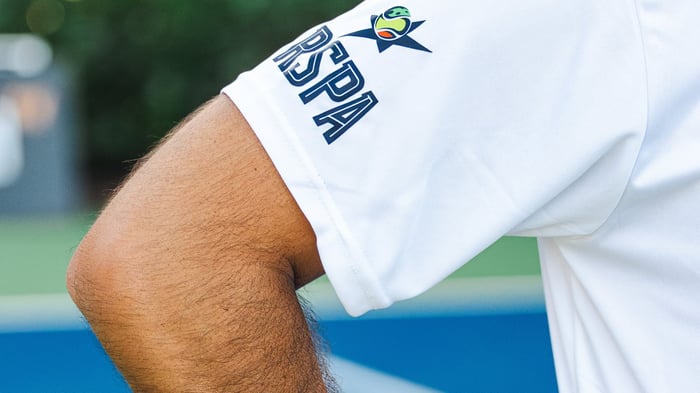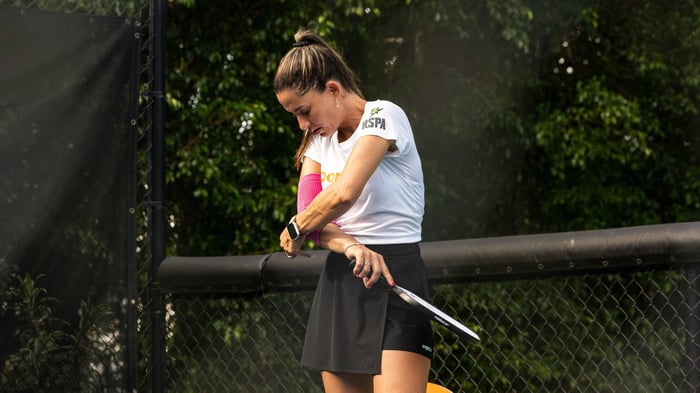Key Takeaways:
Structured and goal-oriented practice sessions are essential for transitioning from casual to competitive pickleball play, focusing on skill development, tactical awareness, and mental toughness.
Incorporating drills for footwork, reaction time, and consistency builds the foundation for reliable shot-making and superior court coverage during high-pressure matches.
Tracking progress with measurable goals and performance metrics ensures continuous improvement and transforms training into purposeful preparation for tournament success.
What turns a weekend player into a tournament contender is a disciplined, strategic approach to training. Casual games build familiarity, but competitive success comes from structured sessions that develop muscle memory for advanced pickleball shots, tactical awareness, and mental resilience. Instead of random rallies, focus on deliberate skill work, progressive challenges, and measurable improvement to perform consistently under pressure.
A competitive training plan should target every aspect of your game like goal-driven drills, advanced shot-making, footwork, and reaction time while connecting you with players who share your ambition. Pair these strategies with performance gear built for high-intensity play, and each session becomes a step toward peak performance. Explore PB5star’s performance apparel and footwear to equip yourself for the demands of competitive pickleball and gain the edge where it matters most.
Structuring an effective pickleball practice session
A competitive practice session works best with a clear, systematic flow that maximizes every minute on the court. Instead of aimless hitting, follow a structure that builds the foundation for tournament success through targeted skill development.
Four key phases of an effective session:
Dynamic warm-up – Prepare your body for intense movement.
Focused skill drills – Sharpen specific techniques like dinks, third-shot drops, or serves.
Tactical play – Simulate match conditions and decision-making under pressure.
Cool-down – Aid recovery and prevent injury.
Set measurable goals for each segment to turn practice into purposeful training. Examples include increasing third-shot drop accuracy by 20% or completing 15 consecutive cross-court dinks. Many competitive players drill 6–10 hours weekly across 3–5 sessions, with each 2-hour session covering all four phases at high intensity.
Incorporate both singles and doubles scenarios, rotate formats, and use match simulations to adapt to varied tournament challenges—because adaptability often separates good players from great ones.
6 drills to improve footwork and reaction time
Your ability to move with purpose and react in split seconds can make or break those game-changing moments. The best competitive players know that superior court coverage and lightning reflexes come from dedicated training. These focused drills improve pickleball footwork and reaction time, transforming your movement patterns from reactive to instinctive.
Agility ladder sequences and cone weaving: Set up 5-7 cones in a zigzag pattern spaced 3 feet apart, then sprint through while maintaining low center of gravity and explosive direction changes that mirror real match scenarios
Partner-fed volley bombardment: Position yourself 7 feet from the net while a partner feeds balls from various angles at 2-second intervals, forcing you to develop cat-like reflexes and maintain ready position throughout
Wall rally challenges: Stand 4-5 feet from a solid wall and maintain continuous rallies for 30-60 seconds, building hand-eye coordination and training your paddle to respond automatically to unpredictable bounces
Split-step timing drills: Master the split-step technique by having a partner call "now" at random intervals, triggering your small hop with feet shoulder-width apart to simulate real-time opponent contact
Shadow court movement: Move through complete point scenarios without a ball, focusing on proper positioning transitions and anticipating shot placement based on imaginary opponent positioning
Tennis ball catch training: Have a partner drop balls from eye level while you start in athletic position, catching them before the second bounce to sharpen your reaction speed and build confidence in your reflexes
Strategies for building consistency and control
Building reliable shot-making starts with mastering the fundamentals through repetitive practice. Dink drills and third-shot drops form the backbone of competitive pickleball strategies for consistency and control, as these shots require precise touch and placement under pressure. Focus on kitchen drills that emphasize accuracy over power, practicing the same motion hundreds of times until your muscle memory takes over. Maintain steady body positioning and use the same toss point for serves, which research shows can significantly enhance serving accuracy and dependability.
Controlled rallying with a partner at varying speeds builds the mental and physical stamina needed for long matches. Start with slow, deliberate exchanges that prioritize placement over pace, then gradually increase the tempo while maintaining control. This approach reinforces proper technique under different conditions and helps reduce unforced errors during competition. Better positioning and footwork become second nature when you practice these controlled scenarios regularly, allowing you to maintain form even when the pressure mounts.
Your training gear plays a supporting role in developing precision by reducing distractions and providing the stability needed for reliable movements. Performance-focused apparel and shoes designed for court sports help maintain comfort during extended practice sessions, allowing you to focus entirely on technique refinement.
Tracking progress and setting training goals
Competitive players understand that improvement comes from measuring what matters. Without clear benchmarks and consistent documentation, even the most dedicated training sessions can become directionless. Research shows that players with a structured practice regimen see faster improvement compared to those without a plan, making progress measurement a game-changing part of your competitive journey.
Document every session using a training journal or mobile app to record drill performance, match scores, and specific areas where you struggled or excelled during play.
Apply SMART criteria when you set goals. Make them Specific (improve third-shot drop accuracy), Measurable (land 8 out of 10 attempts), Achievable (realistic for your current skill), Relevant (matches your competitive needs), and Time-bound (within 4 weeks).
Schedule weekly reviews of your performance data to identify patterns, adjust training focus toward weaker areas, and acknowledge the victories that keep you motivated.
Track key metrics like unforced errors per game, successful dink rallies, or serve placement accuracy to create objective measures of your development over time.
Celebrate milestone achievements when you reach specific targets, as this positive reinforcement maintains the drive needed for long-term tournament performance.
When you track progress and set training goals for pickleball systematically, you're not just collecting numbers - you're building the foundation for breakthrough moments on the court. The data helps identify strong and weak areas while preventing aimless practice sessions, transforming every training hour into purposeful preparation for your next competitive challenge.
Take your game further
Competitive training takes more than dedication. It demands gear that works as hard as you do. PB5star’s performance pickleball apparel and PB5 Court 2 shoes are built for players who will not compromise on comfort, durability, or style. Dynamic Stability Assist™ technology supports quick directional changes, while lightweight construction keeps you moving freely during high-intensity play.
Choosing PB5star means joining a community of players committed to excellence. Every product is crafted with the same strategic precision you bring to your training, blending function, performance, and style that gets noticed on the court. Discover how the right gear can elevate your competitive edge. Explore our complete collection today and see why serious players trust PB5star to support their pursuit of peak performance.
FAQs
What are the first steps for transitioning from casual to competitive pickleball play?
Start by establishing a structured practice routine that includes specific skill drills rather than just casual rallying with friends. Begin participating in local tournaments or competitive leagues to experience match pressure and identify areas for improvement. Match simulation training becomes crucial at this stage, as it helps you adapt to the mental and physical demands of tournament play while building confidence in high-pressure situations.
What's the ideal frequency for competitive pickleball training sessions?
Most competitive players benefit from 4-5 training sessions per week, with a mix of skill-focused practice, match simulation, and physical conditioning. This frequency allows for adequate skill development while providing necessary recovery time between intense sessions. The key is consistency rather than cramming multiple sessions into just a few days, which can lead to fatigue and worse results.
Which drills are best for solo practice when partners aren't available?
Wall practice remains one of the most effective solo training methods - try practicing dinks against the wall at kitchen line height or work on third-shot drops with a steady arc. Focus on serving practice with proper toss height and developing a reliable routine, as depth over power is what makes serves truly effective. Shadow movement drills and footwork patterns can also be practiced alone to improve court positioning and reaction time.
How does specialized apparel and footwear impact performance during training?
Performance-focused gear directly affects your ability to move confidently and maintain focus during intense training sessions. Proper athletic footwear provides the lateral support and traction needed for quick direction changes, while moisture-wicking apparel helps regulate body temperature during extended practice. Quality gear reduces distractions and discomfort, allowing you to concentrate fully on skill development and tactical improvements.
How can players avoid burnout while maintaining high-intensity practice?
Vary your training intensity throughout the week by incorporating both high-intensity drills and lighter technical work. Schedule at least one complete rest day per week and listen to your body's signals for additional recovery when needed. Mental toughness training techniques like visualization and mindfulness can help manage the psychological demands of competitive preparation while maintaining motivation.








